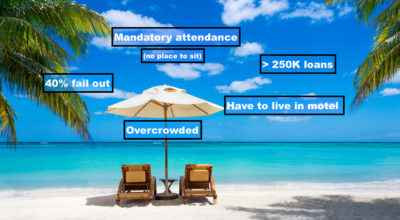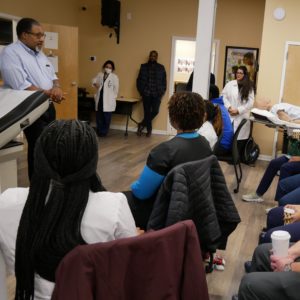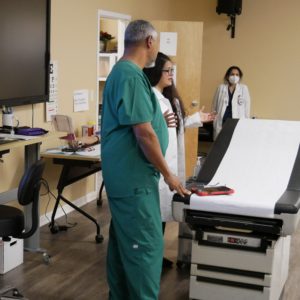What is the best Caribbean medical school
This is a common question asked by many a student entertaining the pursuit of a medical degree in the Caribbean. Unfortunately it’s not that easy a question to answer, as a broad many number of variables weigh heavily in the assessment and ultimate decision. The question centers more so around the individual and specific needs of the student in question and less so on the nuances that define the individual institution under consideration. I think a better question to ask is what is the best Caribbean medical school for the student with a particular learning aptitude, taste or desired academic setting?
Let’s provide some background. Since 1974 nearly 31 US-based allopathic curriculum, offshore medical schools have developed within the Caribbean basin Central and South America. This proliferation has been supported by an almost un-ending demand for medical education seats. The demand, almost universally attributable to the US and Canada’s medical education infrastructures complete inability to service the growing deficit; caused by existing physicians retiring out or costing out due to mal-practice insurance premiums.
So how does one choose one institution over the other? The simple facts are that these schools have more in common than differs, yet each individual institution uniquely speaks to a given student demographic with near laser focus upon their particular individual academic interest and histories. One might ask how this is possible given that they are all delivering the same academic program, utilizing substantively the same curriculum and teaching to exactly the same standardized medical board examinations. The answer may surprise you. But before we get to the specific answer let’s look at the schools in groupings of similarity.
The Big Four
Our first group of schools include three of the oldest US-based offshore medical schools and includes one newer but well established institution, who collectively are commonly referred to as the big four. These schools were formed in a period of emergence that took place between 1976 through 1992. More than anything else what has enabled them to outpace their competition in the Caribbean has been there access to US Title IV federally guaranteed educational loans.
- George’s University School of Medicine SGU located on the island of Grenada was founded in 1976 is the largest and most established of the Caribbean medical school’s with 6300 active students 14,000 graduates and an academic staff nearing 2300. It is widely recognized as being the top of the Caribbean medical schools and most academically similar to a US or Canadian school; both in admissions challenges and tuition cost.
- Ross University School of Medicine located on Dominica was founded in 1978, has 3500 active students historically thought of as a quality school producing respected physicians especially in the area of family medicine and clinical research. Recent years post its acquisition by DeVry education its reputation has been muddied by its association with AUC and DeVry ( see https://www.ripoffreport.com/reports/ross-university-school-of-medicine/select-stateprovince/ross-university-school-of-medicine-devry-ross-university-school-of-medicine-with-over-40-1093042 )
- American University of the Caribbean AUC located on Dutch St. Maarten, post moving from Montserrat was founded in 1978, 1000 active students 75 faculty and staff. AUC was acquired by DeVry education in Dec 2011, AUC is generally respected but has endured significant negative press in recent years for a number of failings associated with the academic performance of its students on the USMLE boards, residency match and timely access to quality clinical experience. DeVry has had a difficult time establishing itself as a credible organization with numerous litigations, claims of misleading it students and assorted questionable business practices.
(see https://www.denverpost.com/2013/09/10/devry-lures-medical-school-rejects-as-taxpayers-fund-failed-debt/ https://www.ftc.gov/news-events/press-releases/2016/12/devry-university-agrees-100-million-settlement-ftc http://hcrenewal.blogspot.com/2016/01/who-can-you-trust-ftc-charges-devry.html )
4, Saba University located on the Dutch island of Saba was founded in 1992 is a well-respected and well run institution having graduated more than 2500 students since its inception. Saba is operated by investment fund holding company R3 Education that acquired and manages two other for-profit education institutions, medical University of the Americas located in St. Kitts & Nevis and St. Matthews University located in Cayman. R3 education is headquartered in Devens Mass. and led by CEO Steven Rogers. Academically similar to the “Big four “respective ECFMG compliant allopathic curriculum’s and programs targeted at the USMLE standardized board examinations. These next schools are smaller, younger and offer differing educational environments.
- Mathews University is a for-profit University located in Grand Cayman and operated by R3 Education. The school was founded in 1997 in Belize by Michael Harrison and a group of physicians in 2002, the school relocated to Grand Cayman. In addition to the school of medicine St. Matthews operates a school of veterinary medicine. St. Matthews trained family medicine physicians are widely recognized as having a sensitive bedside manner. While certain St. Matthews is clearly a quality school it has suffered from frequent shortages of clinical slots and has a high student attrition rate due to outbound transfers of students looking for more predicable clinical education opportunities.
- American University of Integrative Sciences School of Medicine AUIS located on Barbados was founded in 1999 as St. Eustatius University School of Medicine. The school changed its name post its relocation and ultimate acquisition by International Education Management Resources IEMR, an Atlanta based investment group led by CEO Milo Pinckney. AUIS is best known for the quality of its robust clinical medicine program and student centric administration. Recent years have seen a heavy technology investment in the schools teaching environment, a focus on maintaining high student faculty contact, facilitated through small class sizes and regulated by an administratively imposed 11 to 1 student faculty ratio, which limits its student population to 115 in its basic science program. AUIS has historically produced high quality family medicine physicians. Since its acquisition it has introduced the only NIH recognized CAM strategy enriched academic program in the Caribbean; resulting in its graduates possessing a rich knowledge of NIH compliant complementary and Alternative medicine modalities and practices. AUIS has shown great progress since 2013 with USMLE pass scores and Residency match statistics that are competitive with its larger and more recognized competitors.
- American University of Antigua AUA located on the island of Antigua was founded in 2004, has an active student population of 1950 students. AUA was cofounded by Neil Simon a lawyer and former president of Ross University. In 2008 Manipal Education and Medical Group purchase the University from New York-based Caribbean learning resources. In 2006 AUA was approved by the New York State education Department and recognized by the medical Board of California enabling it to gain access to US title IV education loans. AUA is a fine school with quality clinical rotations and competitive USMLE board scores and residency match statistics.
- University of Medicine and Health Sciences UMHS is one of the younger universities founded in 2007 by Robert Ross of the Ross University family and located in St. Kitts & Nevis. UMHS is a fine school with an experienced administration, stellar campus facilities and ample development resources. However, UMHS has a faculty that is disproportionately comprised of PhD and MBBS instructors who have no direct experience with the USMLE board exam that their students are training to.
The list of Caribbean schools is too large for us to provide a synopsis of each in this article, but we have given you a brief introduction to some of the elements that will help you draw a conclusion as to which best serves your education needs. To see a list visit https://en.wikipedia.org/wiki/List_of_medical_schools_in_the_Caribbean
Accreditation
Many of the schools list the various recognitions and accreditations that they enjoy, but what is the importance of accreditation of an offshore medical school in practical terms? The answer to this question is also subject to opinion. Here are the facts from an historical and present day relevance perspective, I encourage you to make your own interpretation. Historically it did not matter if a school was accredited. Why? You ask, because as long as the school was authorized to sponsor a student to sit the USMLE and that student passed with a competitive score; than they were eligible for residency match. Consequently the only other functional benefit of accreditation was access to US federal loans, which required the participating institution to have a US DOE number; that was issued only to accredited schools. Many will argue that accreditation speaks to a school’s standards of academic excellence, but that is a subjective assessment as well and we are limiting this discussion to the facts. Now, effective 2024 ECFMG has mandated that all schools sponsoring students to sit the USMLE will have to attain accreditation from an approved accrediting body. As a result you can expect that most all of the Caribbean medical schools will be scrambling to comply with this mandate. So should a student exclude a given school from their consideration based upon current accreditation status? I would say no. Here’s why. The baseline of a schools evaluation is in the quality of their academic program, their student’s access to quality clinical rotations, student’s first attempt USMLE pass statistics, their residency match statistics and their alumni review. These are the practical points where the rubber meets the road and where students considering a school should invest their energy getting accurate and detailed answers. A schools eligibility to sponsor a student is predicated on the subject school having the following:
- Recognition from WHO
- Listing in the FAIMER directory
- Recognition from the host country authority
- Regional accreditation (effective 2024)
Below I have provided an explanation of exactly who these organizations are and what role they play in the medical education realized by the students of these schools.
WHO: The World Health Organization
- WHO fulfills its objective and functions as the directing and coordinating authority on international health. The WHO established and maintains effective collaboration with the United Nations, specialized agencies, governmental health administrations, professional groups and such other organizations as may be deemed appropriate to assist Governments, upon request, in strengthening health services, to furnish appropriate technical assistance and, in emergencies, necessary aid upon the request or acceptance of UN member Governments, to provide or assist in providing, upon the request of the United Nations, health services and facilities to special groups, such as the peoples of trust territories, to establish and maintain such administrative and technical services as may be required
FAIMER: Foundation for the Advancement of International Medical Education and Research
FAIMER is a nonprofit organization whose mission is to “support the Educational Commission for Foreign Medical Graduates (ECFMG) as it promotes international health professions education through programmatic and research activities.” These activities include: Creating Educational Opportunities for Health Professions Educators that support the exchange of educational expertise, acquisition of new methodologies in teaching and assessment, and pursuit of advanced degrees in health professions education. Additionally they are responsible for discovering patterns and disseminating knowledge about the relationship between health professions education and health care, and the impact of physician workforce and migration issues on the functioning of health care systems. FAIMER is actively engaged in developing Data Resources to develop and maintain accurate, publicly available information that promotes an understanding of the world’s health professions education systems today, and how they should look tomorrow. Among FAIMER’s data resources is the International Medical Education Directory (IMED), a free web-based listing of medical schools that are recognized by the appropriate government agencies in the countries where the medical schools are located.
CAAM-HP: The Caribbean Accreditation Authority for education in Medicine and other Health Professions
- The purpose of CAAM-HP is to serve as an accrediting body for medical, veterinary, and dental schools in the 15 member nations of the Caribbean Community (CARICOM). The departments of education from both United States and Canada contacted the Educational Commission for Foreign Medical Graduates(ECFMG) and has required that all Caribbean Medical Schools be at the standard of United States and Canadian medical schools, this led the CARICOM to create the Caribbean Accreditation Authority for Education in Medicine and other Health Professions (CAAM-HP)[4] organization who will be assessing Caribbean medical schools.
ACCM: Accreditation Commission of Colleges of Medicine
- ACCM is an independent international medical review and accreditation agency service for medical schools. While they are recognized by NCFMEA, they are less relevant since the Caribbean has adopted CAAM-HP as their NCFMEA compliant standard.
NCFMEA: National Committee on Foreign Medical Education and Accreditation
- The purpose of the National Committee on Foreign Medical Education and Accreditation (NCFMEA) is to review the standards used by foreign countries to accredit medical schools and determine whether those standards are comparable to standards used to accredit medical schools in the United States.
US-DOE
The primary functions of the Department of Education are to “establish policy for, administer and coordinate most federal assistance to education, collect data on US schools, and to enforce federal educational laws regarding privacy and civil rights
What’s driving the future of international medical education?
Depending upon the statistics presented within whichever article you read, you will learn that America and Canada collectively have a projected physician shortage of nearly 400,000 anticipated by 2025. This is substantiated by a corresponding statistic that speaks to what has already happened in US and Canadian hospitals. In 1997 17.7 % of the physicians practicing in US and Canadian hospitals were identified as being foreign trained or IMG’s. Today that number is 29.2% and is projected to grow at a greater rate than for the 21 year period referenced. Many say that there is a stigma attached to having attended an international medical school. The truth is for a limited factually ignorant subset of the population this is true. What is not widely known is that the greater majority of the Caribbean and central South American medical schools are all American owned and run from US headquarters. These institutions deliver an academic curriculum that mirrors their US institutional counterparts and teaches to exactly the same standardized test sat by all American students. In fact the majority of the offshore schools use the NBME subject shelf examinations within their basic science programs as a USMLE preparatory standard for their students.
Those that snub the IMG have not bothered to observe the real world statistics, which solidly prove otherwise.
Excerpted from 2/17/17 Reuters article (Reuters Health) – U.S. patients may have lower mortality rates if their doctors were trained at foreign medical schools rather than at American universities, a recent study suggests. After accounting for other factors that could contribute to patients’ outcomes, the mortality rate was 5 percent lower for foreign medical graduations. But that’s large enough to impact tens of thousands of patients nationwide.
International medical graduates make up a quarter of the physician workforce in the U.S., the UK, Canada and Australia, researchers note in the BMJ. In the U.S., doctors trained elsewhere treat a far greater proportion of patients in many rural and underserved communities, previous studies have shown.
The research team points out that in order to get a license to practice medicine in the U.S., foreign medical school graduates must pass two examinations that test medical knowledge and one examination that assesses clinical skills, and they must also complete several years of accredited residency training in the U.S.
Researchers examined data for more than 1.2 million hospitalizations handled by general internists at U.S. hospitals and found patients were slightly less likely to die within 30 days after admission if their doctor went to medical school in another country.
The decision point
As Most students feel that, ideally they would prefer to attend a US or Canadian domestic school. This is understood and requires little explanation. The interesting facts surrounding this is that of those that are academically qualified, only 2 out 11 will gain one of the coveted seats. The remaining nine will be left with the choice to try again next year, where they will be competing with the latest recent undergrads or consider the international option. Don’t be discouraged….! This simplifies the decision tree substantially. As some of these nine students you will have the opportunity to stand out as a top competitors in most any of the Caribbean schools including St Georges, the sector leader.
So, given the projected shortage of physicians and the limited number of available slots in US and Canadian schools, the opportunity for qualified students to attain a quality education is significantly greater within the Caribbean basin. The negatives associated with breaking from the statistical norm are well outpaced by the opportunity to realize your dream of becoming a practicing physician within the US or Canada. You will face obstacles, challenges and an occasional snub from US trained physicians, but you will be every bit their equal and in some cases their superior. The most important point=++= is that you will be a practicing physician, making a difference in the lives of those you touch and provide care to. You will be part of a community that improves lives, communities, economies and the greater world.
Choose wisely



